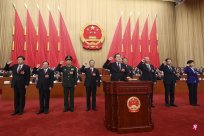The data released by the People's Bank of China last Friday (March 10) showed that in January, RMB foreign exchange accounts increased for the fourth consecutive month, an increase of 153.7 billion yuan (RMB, the same below, about S $ 30 billion)The biggest since March 2014.
According to Bloomberg, foreign exchange accounts are formed by the central bank's use of local currency to purchase foreign exchange.After the central bank withdrawn from the market's normalized intervention in 2017, the monthly fluctuations of this project have been greatly weakened.When the central bank announced the data of last year this year, it was related to some commercial banks who voluntarily transferred the renminbi deposit reserve deposited by foreign exchange funds from 2007 to 2008 back to the RMB.The balance of subjects increases.
As the increase expands month by month, market participants have more analysis of this.In February of the WeChat public account of the Financial Market Department of China Construction Bank, the financial institution said that under the "foreign assets -other foreign assets" item with foreign currency deposit reserve reserves, from 2007 to 2008, the deposit was repeatedly increased.After the reserve ratio, the subject increased from 105.2 billion yuan to 1.46 trillion yuan. Since then, as the pressure of foreign exchange payment slows down and the deposit reserve ratio is reduced, the amount of the subject has gradually stabilized. In 2015, it was only 180 billion yuan.It is currently about 900 billion yuan.
The article pointed out that there are still many factors that affect foreign exchange accounts. In addition to the settlement and sales operation of the central bank and the enterprise and the bank, it may also conduct foreign exchange between RMB transactions and foreign countries with the central bank and overseas institutions.Reserve and investment -related foreign exchange settlement operations, or other derivative financial tool transactions conducted by the central bank and financial institutions, but the recent changes in foreign exchange accounts should have nothing to do with the RMB exchange rate situation.
Xing Zhaopeng, a senior Chinese strategist at the Australian and New Bank, said that the continued increase in January may still be due to foreign exchange preparation for replacement; the scale of foreign exchange operations caused by the central bank's policy business such as repayment of foreign bonds and foreign exchange injections is difficult to reach such a large scale.The size of the central bank is not likely to interfere with the foreign exchange market.
From November last year to January this year, the monthly appreciation of the RMB in the shore was more than 2%, or even nearly 3%.There is no large surplus on the sales of valet sales, which means that the central bank's necessity of quantitative market intervention is not large.In January, foreign exchange reserves increased by 56.771 billion US dollars (about S $ 76.4 billion) from the previous month. The Foreign Exchange Bureau announced the comprehensive role in the converted rate of exchange rates and asset price changes.


